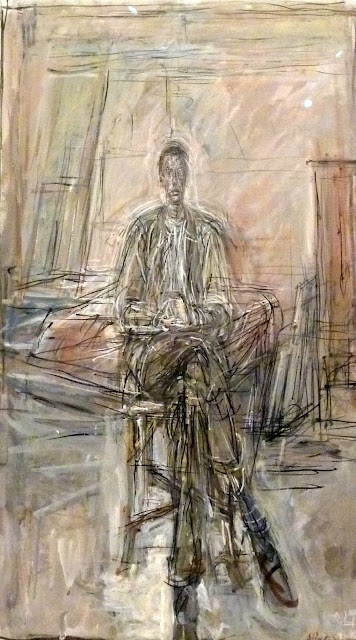Friday, 7 December 2012
Tate Modern
Tate Modern.
A few of the works in the permanent collection.
Alberto Giacometti, Seated Man, 1949
Seated Man depicts Giacometti's brother Diego, one of his most frequent models. Even this familiar face became an object of investigation and discovery for the artist who commented 'when he poses for me I don't recognise him'.
Alberto Giacometti, Man Pointing, 1947
This was made very rapidly for Giacometti's first exhibition in New York. He recalled: 'I did that piece in one night between midnight and nine the next morning. That is, I'd already done it and demolished it and did it all over again because the men from the foundry were coming to take it away. And when they got here, the plaster was still wet'. It was originally intended to be part of a larger composition, with the left arm positioned loosely around the second figure. He later abandoned the idea and considered Man Pointing to be a completed work.
Henri Moore, Upright Internal/External Form, 1952-53
This sculpture reflects the interplay between figurative and abstract forms in Moore's work. 'I have done other sculptures based on this idea of one form between protected by another' Moore recalled. 'I suppose in my mind was also the Mother and Child idea and of birth and the child in embryo. All these things are connected in this interior and exterior idea'.
Later versions of the sculpture were made in bronze and elm wood and a twenty foot high cast is sited on First National Plaza in Chicago.
Lee Crasner, Gothic Landscape, 1961
Although this is an abstract painting, the thick vertical lines that dominate its centre can be seen as trees, with thick knotted roots at their base. It was probably this that led Krasner to call the painting Gothic Landscape, several years after completing it.
Krasner was married to Jackson Pollock and during their years together she relegated her work to second place so as to support and encourage him and to promote his work. This painting was made in the years following his death and belongs to a series of large canvases whose violent and expressive gestural brushstrokes reflected her feelings of grief.
Labels:
modern art,
painting,
sculpture,
Tate Modern,
women artists
Subscribe to:
Post Comments (Atom)







No comments:
Post a Comment